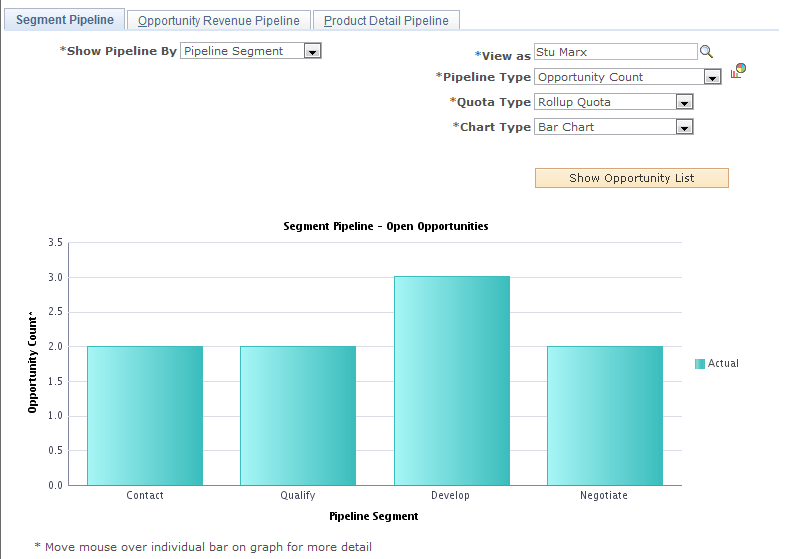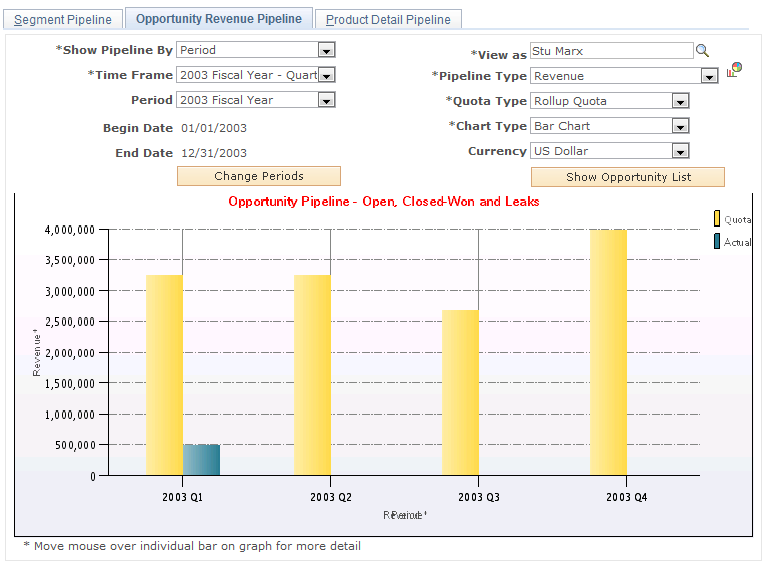Viewing the Opportunity Pipeline
This topic discusses how to:
View the segment pipeline.
View the opportunity revenue pipeline.
View the product detail pipeline.
|
Page Name |
Definition Name |
Usage |
|---|---|---|
|
RSF_PL_SEG |
Configure and view the pipeline of opportunities at different stages of the sales process. |
|
|
RSF_PL_OPP |
Configure and view the pipeline of revenue from opportunities. |
|
|
RSF_PL_PROD |
Configure and view the pipeline of products that are associated with active opportunities. |
Use the Segment Pipeline page (RSF_PL_SEG) to configure and view the pipeline of opportunities at different stages of the sales process.
Navigation
Image: Segment Pipeline page
This example illustrates the fields and controls on the Segment Pipeline page.

|
Field or Control |
Definition |
|---|---|
| Show Pipeline By |
Select how to organize data for the pipeline. Values are: Business Unit. Industry. Pipeline Segment. Pipeline segments correlate with stages in the sales process. This is the default. See Setting Up Pipeline Segments. Region. Sales User. Territory. |
| Pipeline Type |
Select the type of pipeline to render. Values are: Opportunity Count: This count is based on the number of opportunities with the status of Open. Revenue: This pipeline shows the estimated opportunity revenue from the opportunity sales teams' revenue allocation percentages. (You cannot render a pipeline from shadow allocations.) |
Use the Opportunity Revenue Pipeline page (RSF_PL_OPP) to configure and view the pipeline of revenue from opportunities.
Navigation
Select the Opportunity Revenue Pipeline tab on the Segment Pipeline page.
Image: Opportunity Revenue Pipeline page
This example illustrates the fields and controls on the Opportunity Revenue Pipeline page.

The Opportunity Revenue pipeline includes opportunities with estimated close dates that are within the specified time frame and with a status of open, closed-won, or closed-lost. Inactive opportunities are not included. Closed-lost opportunities appear as leaks in the pipeline.
|
Field or Control |
Definition |
|---|---|
| Show Pipeline By |
Select how to organize data for the pipeline. Values are:
|
| Pipeline Type |
Select the type of pipeline to render. Values are:
|
| Time Frame and Period |
Select the time frame and reporting period to use for determining revenue in the pipeline. |
| Currency |
Select the currency used for the pipeline revenue amounts. |
Use the Product Detail Pipeline page (RSF_PL_PROD) to configure and view the pipeline of products that are associated with active opportunities.
Navigation
Select the Product Detail Pipeline tab on the Segment Pipeline page.
Image: Product Detail Pipeline page
This example illustrates the fields and controls on the Product Detail Pipeline page.

|
Field or Control |
Definition |
|---|---|
| Show Pipeline By |
Select how to organize data for the pipeline. Values are:
|
| Pipeline Type |
Select the type of pipeline to render. Values are:
|
| Time Frame and Period |
Select the time frame and reporting period to use for determining opportunities in the pipeline. |